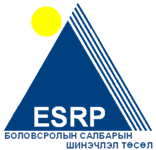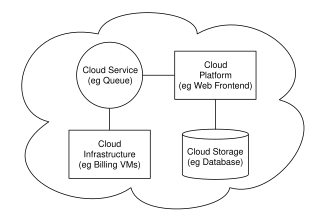Comparisons
Cloud computing derives characteristics from, but should not be confused with:- Autonomic computing — "computer systems capable of self-management"[14]
- Client–server model – client–server computing refers broadly to any distributed application that distinguishes between service providers (servers) and service requesters (clients)[15]
- Grid computing — "a form of distributed computing and parallel computing, whereby a 'super and virtual computer' is composed of a cluster of networked, loosely coupled computers acting in concert to perform very large tasks"
- Mainframe computer — powerful computers used mainly by large organizations for critical applications, typically bulk data-processing such as census, industry and consumer statistics, enterprise resource planning, and financial transaction processing.[16]
- Utility computing — the "packaging of computing resources, such as computation and storage, as a metered service similar to a traditional public utility, such as electricity";[17]
- Peer-to-peer – a distributed architecture without the need for central coordination, with participants being at the same time both suppliers and consumers of resources (in contrast to the traditional client–server model)
Characteristics
In general, cloud computing customers do not own the physical infrastructure, instead avoiding capital expenditure by renting usage from a third-party provider. They consume resources as a service and pay only for resources that they use. Many cloud-computing offerings employ the utility computing model, which is analogous to how traditional utility services (such as electricity) are consumed, whereas others bill on a subscription basis. Sharing "perishable and intangible" computing power among multiple tenants can improve utilization rates, as servers are not unnecessarily left idle (which can reduce costs significantly while increasing the speed of application development). A side-effect of this approach is that overall computer usage rises dramatically, as customers do not have to engineer for peak load limits.[18] In addition, "increased high-speed bandwidth" makes it possible to receive the same. The cloud is becoming increasingly associated with small and medium enterprises (SMEs) as in many cases they cannot justify or afford the large capital expenditure of traditional IT. SMEs also typically have less existing infrastructure, less bureaucracy, more flexibility, and smaller capital budgets for purchasing in-house technology. Similarly, SMEs in emerging markets are typically unburdened by established legacy infrastructures, thus reducing the complexity of deploying cloud solutions.[19]Economics
Cloud computing users avoid capital expenditure (CapEx) on hardware, software, and services when they pay a provider only for what they use. Consumption is usually billed on a utility (resources consumed, like electricity) or subscription (time-based, like a newspaper) basis with little or no upfront cost. Other benefits of this approach are low barriers to entry, shared infrastructure and costs, low management overhead, and immediate access to a broad range of applications. In general, users can terminate the contract at any time (thereby avoiding return on investment risk and uncertainty), and the services are often covered by service level agreements (SLAs) with financial penalties.[20][21]According to Nicholas Carr, the strategic importance of information technology is diminishing as it becomes standardized and less expensive. He argues that the cloud computing paradigm shift is similar to the displacement of electricity generators by electricity grids early in the 20th century.[22]
Although companies might be able to save on upfront capital expenditures, they might not save much and might actually pay more for operating expenses. In situations where the capital expense would be relatively small, or where the organization has more flexibility in their capital budget than their operating budget, the cloud model might not make great fiscal sense. Other factors impacting the scale of any potential cost savings include the efficiency of a company's data center as compared to the cloud vendor's, the company's existing operating costs, the level of adoption of cloud computing, and the type of functionality being hosted in the cloud.[23][24]
Among the items that some cloud hosts charge for are instances (often with extra charges for high-memory or high-CPU instances); data transfer in and out; storage (measured by the GB-month); I/O requests; PUT requests and GET requests; IP addresses; and load balancing. In some cases, users can bid on instances, with pricing dependent on demand for available instances.[citation needed]
Architecture
Cloud architecture,[25] the systems architecture of the software systems involved in the delivery of cloud computing, typically involves multiple cloud components communicating with each other over application programming interfaces, usually web services. This resembles the Unix philosophy of having multiple programs each doing one thing well and working together over universal interfaces. Complexity is controlled and the resulting systems are more manageable than their monolithic counterparts.The two most significant components of cloud computing architecture are known as the front end and the back end. The front end is the part seen by the client, i.e. the computer user. This includes the client’s network (or computer) and the applications used to access the cloud via a user interface such as a web browser. The back end of the cloud computing architecture is the ‘cloud’ itself, comprising various computers, servers and data storage devices.



No comments:
Post a Comment